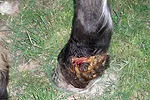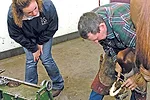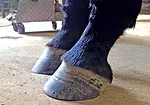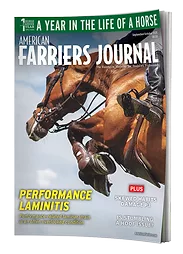Advertise Follow Us
American Farriers Journal

View Archived Issues
December 2012
Volume: 38
Edition: 8
American Farriers Journal is the “hands-on” magazine for professional farriers, equine veterinarians and horse care product and service buyers.
-
Table Of Contents
Table Of Contents
Shoeing for a LivingShoeing Along the Colorado Front Range
Farrier J.D. Downs is becoming known for his work with reining horses, in part because he never hesitates to seek advice from his mentorsRead MoreWire Cut, Infection Takes 7 Years of Treatment
A serious pastern injury and later infection to the sensitive lamina almost cost a Quarter Horse its lifeRead MoreFarriers' Roundtables
What is the best way to trim and shoe a horse with contracted heels? It seems like I often see contracted heels along with a long-toe problem.Read MoreHorseshoeing Habits and HardshipsWhat You're Doing Today Affects Your Health Down the Road
Repetitive stresses, poor work habits and small injuries build up over time, creating damage you’re not aware of until it’s too lateRead MoreThe Hoof-Care Bottom Line40 Business Terms Farriers Need to Understand
Knowing the language of business helps you put your hoof-care business on sounder footing and improves communication with clients from a business background.Read MoreNothing Normal About Zoo Work
Working on the feet of wild animals is not only gratifying, but also very challenging and educationalRead MoreThere's More Than One Kind of Heel Pain
Farriers face heel problems almost daily, but it’s important to understand that there are different causes, requiring different approachesRead MoreGetting the Right Fit With Aluminum
Solid tips from people who have learned their way around working with these important shoesRead MoreUnderstanding What You See Before, During and After
You can’t deliver hoof care without building a thorough and consistent system of evaluating horses’ feetRead MoreA Day of Shoeing Backyard Horses Includes the Good and the Bad -- But Mostly Good
Pennsylvania farrier sees variety — in horses, barns as well as clientsRead MoreThe Backyard HorseWhen it’s Time to End a Business Relationship with Backyard Clients
The reasons may differ, but to have a long, prosperous career with backyard clients, it means you likely will have to fire some of themRead MoreTackling High-Low Syndrome From The High Side
Pennsylvania farrier finds focusing on getting upright hoof under control first helps bring the feet into closer symmetryRead More
















